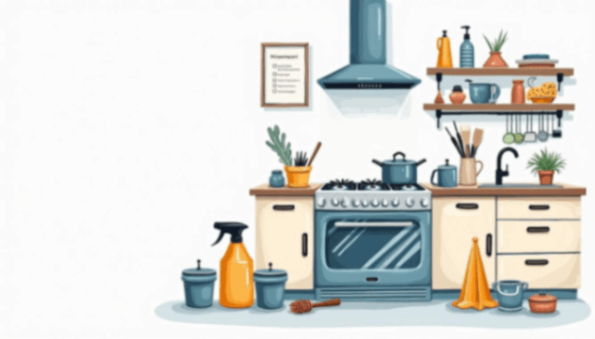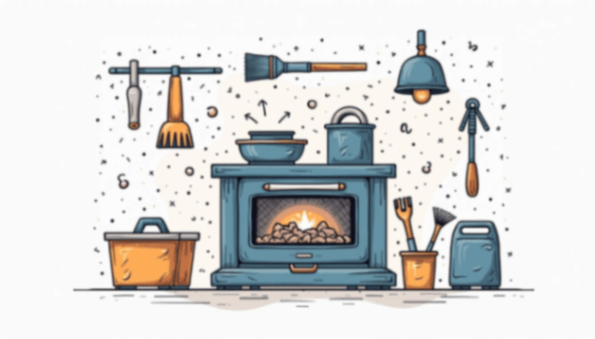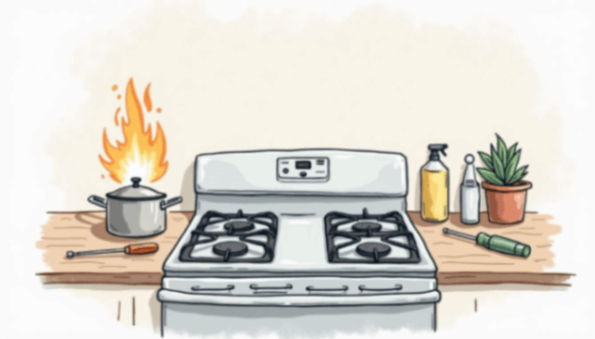Stoves are an essential part of any kitchen. They not only help in cooking meals but also play a significant role in ensuring safety and efficiency in culinary tasks. To maintain your stove properly, it is essential to understand its functionality and components, recognize the importance of ongoing maintenance, and follow best practices for care and upkeep. This article will provide a comprehensive guide on how to maintain your stove for maximum efficiency and safety.
Understanding Your Stove's Functionality
To effectively maintain your stove, you first need to understand its functionality. This involves knowing how different types of stoves operate and their unique features. Different stove designs—be it gas, electric, or induction—offer various benefits and come with specific maintenance requirements. Each type not only influences your cooking style but also impacts energy consumption and safety considerations, making it essential to choose the right one for your kitchen needs.
Types of Stoves and Their Unique Features
There are primarily three types of stoves: gas, electric, and induction. Each type operates differently and requires a unique maintenance approach:
- Gas Stoves: These work by igniting gas with a flame, offering precise temperature control. They are favored by many chefs for their immediate heat response and the ability to visually gauge the flame size, which can be crucial for certain cooking techniques.
- Electric Stoves: They use heated coils or smooth tops that maintain even heat. Electric stoves often come with features like self-cleaning ovens and timers, making them convenient for busy households.
- Induction Stoves: These utilize magnetic fields to heat cookware directly, which is energy-efficient. Induction cooking is not only faster but also safer, as the cooktop remains cool to the touch, reducing the risk of burns.
Understanding these differences helps you tailor your maintenance practices effectively. For instance, gas stoves may require regular checks for gas leaks and burner cleanliness, while electric stoves benefit from periodic cleaning of the heating elements to ensure optimal performance.
Key Components of a Stove
The stove consists of numerous components that play critical roles in its function. Key components include:
- Burners: The heat source where cooking takes place. Burners can vary in size and power, allowing for versatile cooking options from simmering sauces to boiling water quickly.
- Control Knobs: Used to adjust heat levels and turn the burners on/off. These knobs can sometimes wear out or become sticky, necessitating replacement to ensure precise control.
- Heating Elements: Found in electric stoves, these wires are responsible for generating heat. It's important to inspect them regularly for any signs of damage or wear, as faulty elements can lead to uneven cooking.
- Oven Thermostat: This controls the temperature inside the oven to ensure consistent cooking. A malfunctioning thermostat can result in undercooked or burnt food, making it crucial to check its accuracy periodically.
Knowing these components will enhance your ability to troubleshoot issues and perform maintenance tasks effectively. Additionally, understanding how to clean and care for these parts can prolong the life of your stove. For example, regular cleaning of the burners and heating elements can prevent grease buildup, which not only affects performance but can also pose a fire hazard. Furthermore, familiarizing yourself with the user manual can provide insights into specific maintenance tips tailored to your stove model, ensuring optimal functionality and safety in your cooking endeavors.
Importance of Regular Stove Maintenance
Regular maintenance is critical not just for efficiency but also for ensuring safety while cooking. Ignoring maintenance can lead to decreased performance and potential hazards.

Enhancing Efficiency Through Maintenance
Keeping your stove clean and well-maintained enhances its operating efficiency. Built-up grease and residue can hinder performance, leading to uneven cooking and increased energy waste.
Regular cleaning sessions can ensure that burners and heating elements work correctly, and inspections can identify issues before they escalate. Integrating proper maintenance habits can save money on energy bills in the long run.
Moreover, a well-maintained stove can significantly improve the quality of your cooking. When burners are clean and functioning optimally, they provide consistent heat, allowing for precise temperature control. This is especially important for delicate dishes that require careful attention to heat levels. By investing time in maintenance, you not only enhance efficiency but also elevate your culinary skills, making every meal a delightful experience.
Ensuring Safety with Proper Upkeep
Safety is paramount in any kitchen. Stoves that are not properly maintained can pose serious risks, including fires or gas leaks. Regular inspections help in identifying problems like damaged seals or malfunctioning burners.
Additionally, checking for gas leaks using soapy water can provide peace of mind and prevent dangerous situations. Ensuring that your stove is in good working order safeguards not just your home but also the lives of those within it.
Furthermore, understanding the specific safety features of your stove can enhance your overall kitchen safety. Many modern stoves come equipped with automatic shut-off features and flame failure devices that can prevent gas from leaking if the flame goes out. Familiarizing yourself with these features and ensuring they are functioning correctly can add an extra layer of protection. Regular maintenance not only addresses immediate concerns but also reinforces a culture of safety in the kitchen, encouraging everyone to be vigilant and proactive about potential hazards.
Step-by-Step Guide to Stove Maintenance
Now that you understand the importance of maintenance, here’s a step-by-step guide to effectively maintain your stove.

Cleaning Your Stove Regularly
Regular cleaning is the cornerstone of stove maintenance. Start by removing loose debris, then use a suitable cleaner to wipe down surfaces. For gas stoves, clean the burner caps and grates thoroughly, allowing the burners to work efficiently.
For electric and induction stoves, ensure the smooth tops are polished with appropriate cleaners to prevent scratches and staining. A clean stove is not only more efficient but also safer and more aesthetically pleasing. Additionally, consider using a mixture of vinegar and baking soda for a natural cleaning solution that can tackle stubborn stains without harsh chemicals. This eco-friendly approach not only protects your family’s health but also helps maintain the integrity of your stove’s surfaces over time.
Checking and Replacing Stove Parts
Inspect frequently used parts like burners, ignitors, and heating elements for wear and tear. If you notice any issues, replacing parts proactively can prevent further damage or complete failure of your stove.
It’s advisable to refer to the manufacturer’s recommendations for part replacement and to use original parts for best results. Keeping your stove in optimal condition extends its lifespan and functionality. Additionally, don’t overlook the importance of checking the stove’s electrical connections and gas lines, as these components are crucial for safe and efficient operation. Regularly tightening connections and inspecting for leaks can help prevent hazardous situations and ensure your stove operates smoothly.
Scheduling Professional Inspections
In addition to regular upkeep, consider scheduling professional inspections at least once a year. A qualified technician can provide a thorough review, catching issues that might go unnoticed during routine cleaning.
Professionals often have better tools for deep cleaning and can identify potential risks, giving you an added layer of confidence in your stove’s operation. During these inspections, technicians can also offer valuable insights on how to optimize your stove’s performance based on your cooking habits. They may suggest adjustments to improve efficiency or recommend upgrades that can enhance your cooking experience, ensuring that your stove not only meets safety standards but also aligns with your culinary needs.
Troubleshooting Common Stove Problems
Being aware of how to troubleshoot your stove can save you both time and money. Learn to recognize the early signs of malfunctioning and deal with common issues promptly.

Recognizing Signs of a Malfunctioning Stove
Some signs that your stove may not be performing well include:
- Irregular Heat Distribution: Food is overcooked on one side and undercooked on another.
- Burner Failure: A burner that doesn’t ignite or heat properly.
- Unusual Noises: Whistling or popping sounds can indicate underlying issues.
Recognizing these early indicators helps you address problems before they escalate into larger, more costly repairs.
Basic Fixes for Common Issues
Some common stove issues can be fixed without needing a professional. For example:
- Uneven Cooking: Ensure the burners are clean and functioning correctly.
- Ignition Problems: Check the igniter and clean any residue preventing the spark.
- Faulty Thermostat: Calibrate or replace your oven thermostat if temperatures vary.
Consult your user manual for specific troubleshooting tips tailored to your stove model.
Tips for Prolonging Your Stove's Lifespan
Finally, here are some tips that can help you prolong the lifespan of your stove, ensuring it remains a reliable kitchen appliance for years.
Best Practices for Daily Stove Use
Developing good habits can make a significant difference in how long your stove lasts. Always use pots and pans that match the burner size, avoid dragging cookware across the surface, and refrain from using the stove as a storage area.
In addition, stay vigilant while cooking by not leaving the stove unattended, which can help prevent accidents and maintain operational integrity.
Investing in Quality Stove Accessories
Quality stove accessories can also contribute to efficient cooking and ease of maintenance. Consider investing in high-grade cookware that distributes heat evenly and is easy to clean. Using stove covers can also minimize grime accumulation.
Additionally, choosing accessories designed specifically for your stove type will optimize performance and may reduce wear on your appliance.
In conclusion, maintaining your stove involves a combination of understanding its functionality, keeping it clean, replacing parts as needed, and recognizing signs of wear. By implementing these practices, you can maximize both the efficiency and safety of your stove, ensuring that it serves you well for many years to come.










